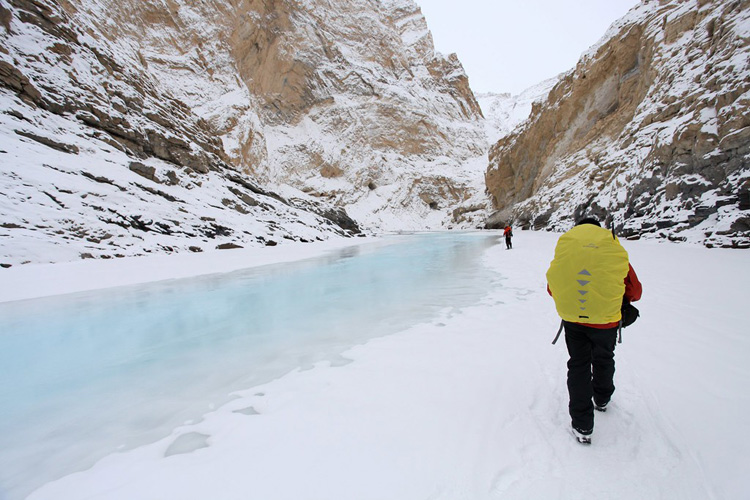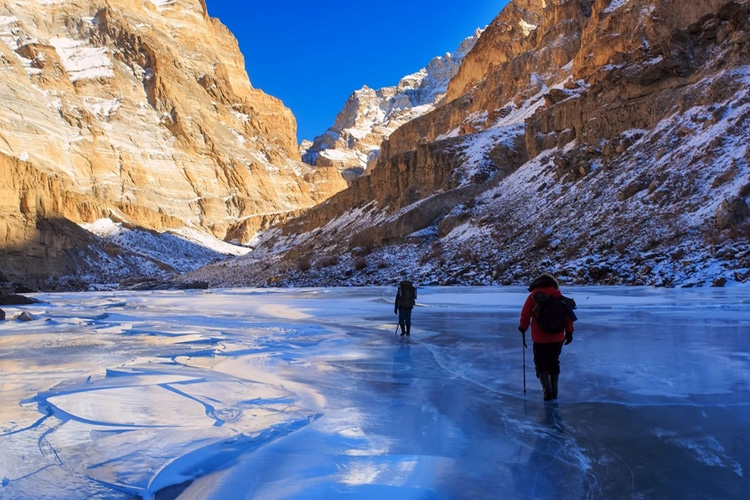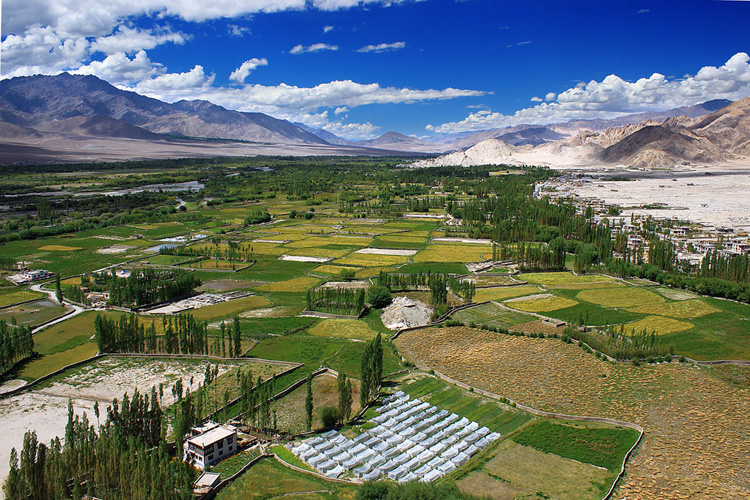



The Chadar trek package adventure begins in the highland town of Leh. The Leh Airport is completely covered with snow, giving it a snowy appearance. The journey crosses the Zanskar River, which freezes in the winter, and offers views of the snow-capped mountains as it descends towards Leh, which is situated at an elevation of 11400 feet above sea level. The months of January and February are ideal for ice-crossing because this is when the ice is usually the most stable. When the Zanskar River starts to ice, a little settlement called Nerak is where the frozen river trip starts.
The easiest way to reach Leh is by flight , Airport of Leh is Kushok Bakula Rimpochi Airport(IXL) it is around 4 km far from the City, it is connected to Delhi and from major Cities of India too.
• Across the ice – It’s important to identify safe routes across the unstable sheet and to constantly be mindful of the ice conditions beneath your feet because the ice may be just as dangerous at times as it can be safe. The environment is around twenty degrees below freezing point and gets even colder after nightfall. Trekkers can stay where the ice is the most stable, or they can camp in the caves along the banks like the locals do. Moving around as much as possible is advised, as is dressing warmly and in layers. This usually aids in maintaining body temperature, avoiding cold sores, and preventing blood freezing.
• Be safe – It is advisable to avoid any gaps in the ice and to stay aware of the conditions of the ice at all times. There are a number of things to take into account to ensure a safe travel. The ideal places to walk normally are those that have a layer of snow on them. The majority of these criteria are related to the ice’s state and the trekker’s choice of footing.
• The precautions – The trekker needs to be aware of the state of the ice sheet; any cracks in the ice should be avoided right once, and the ideal places to walk are those that have a layer of snow on them. There are also areas with slippery ice, which should be traversed with extreme caution. The ice is not necessarily a trekker’s friend, therefore one should always respect it and be aware of the conditions at all times when picking the camping spot. Cracks may occur under one’s feet without warning, necessitating an immediate move to more stable footing.
• Trekking information – The equipment needed for trekking should be taken from home because there aren’t many stores open in the winter to buy supplies. Foods that can be rapidly prepared and preserved, such instant noodles, are a great choice. In order to stay warm and maintain momentum during the journey, it is advised to have enough supplies before beginning. Lightweight hiking boots, trekking poles, and multiple layers of additional warm clothing are essential in these kinds of situations.
• Who can participate –
• Age should be 15 years
• The climber must be fit and have sufficient stamina to cover 6 km of distance in 30 minutes without a stress.
• Experience of any high altitude trek, at least 1 treks of 5,000m/16,400ft.
• The climber should be able to carry a backpack of 12- 15 kg.
• Important Note –
• Junior trekkers (below 15 years) should have a company of parent and guardian.
• Trekkers between 15 to 18 years can come solo with the disclaimer form signed by parent/guardian.
• Heart problem, Very High blood pressure, Asthma, and Epilepsy cannot be reconciled on these missions. The climber must not have these conditions.
One of the most beautiful airports you will ever see, Leh Airport, awaits your arrival. Just before landing, the full range of snow-capped peaks will greet you, leaving you speechless. As soon as you arrive at the Leh airport, the temperature drops sharply, therefore it’s imperative to have your warm garments on hand.
It’s crucial that you become acclimated to the cold in Leh because the temperature only tends to drop as you begin to walk on the frozen Zanskar River. Once you arrive at the guesthouse, you will have plenty of time to unwind and adjust to the surroundings. Later in the evening, you can shop and explore Leh culture at the Leh market. It can get as cold as -10 to -15 degrees during the day from the end of January to mid-February. To keep your body hydrated and regulate its temperature, you should increase your intake of fluids.
• Overnight. Stay in hotel (Leh) centrally heated room
According to the new rules, everyone undertaking the Chadar Trek must stay in Leh for a minimum of two days in order to allow their body to properly adjust to the weather. This requirement is irreversible, so it’s critical that every hiker adhere to it. While you can spend the day exploring the city, it is advised that you stay away from locations that are higher up. Alternatively, you can come along with us for a 3- to 4-hour guided tour that covers all the main attractions in Leh.
• Overnight. Stay in hotel (Leh) centrally heated room.
The third day of the Chadar trek package is crucial since it determines whether you go on or not. The officer’s clearance is a prerequisite for receiving the all-clear to begin the Frozen River Trek with Chadar Trek.
In addition, the trekkers will receive their insurance, wildlife permits, and other necessary paperwork. Should you feel that you have been declared unsuitable by the government or would like to opt out, you can obtain a physical Wild Card and choose a Flavor of Winter Ladakh tour at no additional cost.
Overnight. Stay in hotel (Leh) centrally heated room
On the fourth day of the Chadar Trek Package, you will travel via Chilling to the first campsite, Tsomo Paldar. Shingra Koma, the most distinctive location in Chadar, is situated at the U-bend of Zanskar, creating a beautiful area with an abundance of vistas. Today will be one of the most picturesque drives, allowing you to see some of the most popular locations in Ladakh. After a three to four-hour drive over the Zanskar, you will arrive in Shingra Koma. Some spots to stop and snap pictures are Gurudwara Pathar Sahib, Magnetic Hill, and the confluence of the Zanskar and Indus.
You will be dropped by car where the road ends this will be your starting point of walking on the Zanskar, the layer of Chadar may seem thin here you can also see various rock formations, walking with gumboots on it will definitely be a challenge in the initial stage, understanding the ice patterns will take time, slowly but steadily you will know which surface is fragile and which is trustworthy. There are multiple number of ice surfaces that you would come across while walking on the mighty Zanskar and as you start walking you will know more about it, planting your foot will be important in most of the cases, you can check for the ice for its steadiness with your walking stick before stepping on it wholeheartedly. A small and light backpack will help as you will able to manage your body weight in an effective manner after an hour and half of slipping, falling and trying to gather your balance you’ll be reaching your first campsite at Tsomo Paldar.This will be your first experience of camping under sub-zero temperatures.
• Overnight. Stay in tents
Chadar is one of those treks where you don’t gain height quickly, but rather gradually, from Tsomo Paldar to Tibb Cave (about 7 hours), you gain 400 feet. (Tsomo Paldar: 11,400; Tibb Cave: 11,800). After a cold night in the tent at Tsomo Paldar, finish your meal, which will re-energize your senses in the morning. The much-needed hot cup of tea will be special in such frosty conditions, as you start heading to the next campsite, which is Tibb Cave. This trek route has some of the most eye-catching frozen waterfalls that stand frozen in time, the source of some of these frozen waterfalls is still unknown, and there are a lot of.
After walking for couple of hours, you’ll come across diverse rock designs along the path that appear like art as the sunrays fall on them as they make their way from behind the clouds. You will camp near Tibb cave, which is bordered by barren sand.
Overnight Stay in tent
The 13 km track will lead you to the most famous sight on the Chadar Trek as you continue on to Nerak, the most anticipated campground of the journey. For example, the frozen waterfall, which draws trekkers from all over the world, is a magnificent work of nature. You will be served a hot lunch while traveling to Nerak.
The temperature at Nerak will drop to as low as -30 degrees at night, making it the coldest campsite on the trek. It’s crucial that you dress appropriately and in layers to protect yourself from the bitter cold. If you make it to the waterfall in time, you may also be able to visit the Nerak Village.
Overnight Stay in tents
You’ve heard stories about how fickle the weather is here. On your route back from Nerak, the formation of Chadar may no longer exist, and you may see a fresh layer of Chadar form at times.Even though it’s the same route, you’ll be amazed at how different it looks on the way back.
Chadar Trek is a once-in-a-lifetime experience that every trekking enthusiast should have. What if we told you that these eight days of your life will be some of the most unforgettable and best you’ve ever had, and that you’ll cherish these moments until the end. Today, trace your way back to Tibb Cave.
• Overnight. Stay in tents.
Again, get up early for a long walk back; it’s not exactly repeating steps because you’ve seen a lot of change. Chadar may have melted, the layer may have thinned, and magnificent rocks are now visible. That is the beauty of the Chadar trip; reach Shingra Koma and prepare to board cars. Another bumpy ride, and you’ll arrive at Leh.
Yes, Chadar Trek is definitely a difficult high altitude trek. Physical fitness is absolutely essential for this trek and those suffering from asthma or other chronic diseases should not go for this trek.
You need to have done at least 4-5 Himalayan treks before you decide to do Chadar trek, out of them at least one should be a moderate one. The trekker must also have an experience of trekking more than 2500 m before, the trekking trail is not difficult per se, but the conditions of the trek are quite harsh. We would definitely not recommend first-timers to go for this trek.
Chadar trek height is 11000 feet.
Chadar Trek Package costs approx Rs.15000/person.
Since you will be trekking in sub-zero temperature, clothing is very important. Layering is the mantra at Chadar trek. Wear layers of clothes. We usually wore our thermals inside, then a tee, a fleece and then our windproof jackets. Here is a list of things that you need to pack for the trek.
The only way to reach Leh during the winter is by flight, Leh Airport is connected with all the major airports of India. While on the flight, you can see the snow-covered mountain ranges and the Zanskar river from a height.
A total of 8-9 days are required for the Chadar Trek Package, you will need 1 day to acclimatize and then another day for the medical checkup at the Government check-up centre. We would always recommend you to spend atleast 2 days for acclimatization to prevent AMS.
Our Destination expert will be happy to help you resolve your queries for this tour.
24/7 Support Available
WhatsApp us
